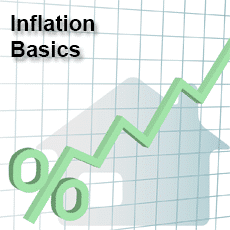 Before we discuss mortgage interest rates and inflation, we must all first agree on what the term ‘inflation’ means. Many believe it to mean the increase of prices in the shops, but that is just a symptom. You should look upon it as being a reduction in the value of your dollar, so you have to spend more dollars to purchase the same car, dress or packet of pasta.
Before we discuss mortgage interest rates and inflation, we must all first agree on what the term ‘inflation’ means. Many believe it to mean the increase of prices in the shops, but that is just a symptom. You should look upon it as being a reduction in the value of your dollar, so you have to spend more dollars to purchase the same car, dress or packet of pasta.
What is Inflation?
The symptoms of inflation are paying more for fuel, clothing, groceries and travel. Your dollar has less purchasing value over time. What you are buying is not becoming more expensive as such, but your dollar is able to pay for less of them. So if last month a box of dried Italian pasta cost a dollar, but now costs $1.05, you need $1.05 to have the same purchasing power as $1 previously.
Inflation hits all the goods and services we purchase in many different ways, although fundamentally the dollar loses value against other global currencies. Here is how mortgage interest rates and inflation are connected.
Mortgage Interest Rates and Inflation
Mortgage interest rates and inflation are closely connected. When the dollar drops in value against global currencies, then the value of everything that is priced using dollars also falls: not their price, but their value. This includes bonds, among them bonds that are backed by the cash flow created by interest payments on mortgages. These are known as Mortgage Backed Securities (MBS.)
Because of this drop in value, demand for these bonds reduces and the stock exchange sells off MBS which leads to more being available on the market – and hence to a reduction in their market price as is normal with any item with low demand. Who wants to purchase an investment that is sure to drop in value and that cannot be sold at a profit!
When the prices of bonds drop, yields increase. Mortgage rates are based upon the yield of these mortgage backed securities. Mortgage rates therefore increase in turn, and put inflationary pressure on the USA economy – and this makes the situation even worse, leading to a continuation of this cycle. It is almost a law of nature: a drop in demand leads to increased interest rates. This is tipped off by the initial drop in the value of the dollar – or what caused that.
When to Lock-In a Mortgage Rate
When you are looking at mortgage rates, therefore, it makes sense to find all you can about the strength of the dollar and the expectation for inflation. The costs of war, for example, can divert resources and increase the price of goods, and so can an increasing demand for commodities by rapidly improving economies such as those of China.
Another inflationary action is the printing of money by the Fed. The more cash in circulation, then the less is its intrinsic value. Increases in income are also inflationary: as more people earn more, they compete for luxury goods, and prices increase. Ultimately this leads to an increase in interest rates, including mortgage interest.
We currently have a stable situation in the USA, but global unrest, the rise in demand for oil, gas, minerals and other commodities by countries such as China and 101 other factors that could affect the value of the dollar can soon change that. Keep your eye open on forecasts.
The Fed has given some security in stressing the current low inflation rate, and this has led to a demand for mortgage backed bonds that has helped maintain lower interest rates- but for how long will MBS be in demand in Wall Street? Mortgage interest rates and inflation go hand in hand – as the value of the dollar drops, rates rise along with shop prices – the consumer takes a financial hit all ways!


About The Author: Karengustin
More posts by karengustin